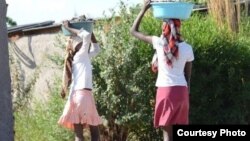The head of PEPFAR, the President’s Emergency Plan for AIDS Relief, says young women and girls are disproportionally affected by HIV. Dr. Deborah Birx said 7,000 young women are infected each week with the AIDS virus – mostly in Africa.
It’s been 34 years since HIV/AIDS was officially declared an epidemic.
While much progress has been made in recent years through treatment and prevention, younger generations remain vulnerable to the virus. And there are a lot more young people today than when the epidemic began as the global population rises. Nowhere can that be seen more clearly than in sub-Saharan Africa.
Ambassador Birx is helping to lead an effort protect women and girls and change the course of the epidemic.
She said, “People have known for a while that women and girls, particularly young women’s incidence of disease and prevalence of disease is much higher than their age-matched boy counterpart. And it starts really very early, probably at about 14 to 15, and then continues to escalate all through the early 20s with a rate that’s about twice what it is in young men.”
Birx said a lot of the infections among young women and girls can be traced to who they date.
“The young girls and young women are not being infected from their age-matched cohort when you see that kind of disparity," she said. "So, you know that they must be getting infected or exposed to the HIV virus probably from a different age cohort of men. And that’s been all of the discussion over the years about cross-generational sex and young women engaging with sex with older men. When we say older men it could be simply five or 10 years older.”
Birx said that health officials have a lot to learn about why adolescent girls and young women make such dating decisions. Earlier in the epidemic, much of the problem was blamed on the so-called “sugar daddy” syndrome, where young women would date rich older men.
But Birx said it’s really more complicated than that.
“You know, we haven’t sat down with young women at 10 and 14 and then again at 15, 16 and 17 and really dissected each of those decisions in different communities,"she said. "I do believe it’s probably different and it’s a different pattern in communities that could be right next to each other.”
The PEPFAR head said the information being gathered will be used to tailor programs toward young women and adolescent girls.
The DREAMS program announced last December is still in its early stages. DREAMS stands for determined, resilient, empowered, AIDS-free, mentored and safe. It’s a public-private partnership PEPFAR has with the Bill & Melinda Gates Foundation and the Nike Foundation. It’ll begin in 10 sub-Saharan African countries.
“Now there’s a difference between defining that they’re at a unique risk – figuring out what that risk is – and then implementing programs that address that risk," Birx said. "And I think we’ve defined that they’re at a unique risk, but we haven’t really defined the type of programming that will affect that risk.”
She said such programs are vital considering population growth.
“If you look at South Africa, itself, about the demographics of the young women in the age category of 15 to 30 at the beginning of the epidemic in 1985 and you look again now of how many young women, there’s about 25 to 30 percent additional young women in that age group," she said. "So this youth bulge – this youth dividend – this fabulous piece of Africa rising – is also the piece that really puts Africa at risk.”
In the early years of the epidemic, Birx treated patients in the U.S. and Africa before the disease was called AIDS. There were a lot of funerals. So, the disease was forefront in many people’s minds. Now, she fears complacency is taking hold.
“The reality of weekly funerals – the reality that HIV/AIDS is death – was so pervasive," she said. "So when Global Fund and PEPFAR and host country investments allowed this amazing saving of lives [and]there was no longer this constant parade of funerals every weekend, it has resulted in a level of complacency that I don’t think any of us expected.”
At the recent World Bank/IMF Spring Meetings in Washington, D.C., Dr. Birx spoke with a number of African finance ministers. She said they told her they thought the HIV/AIDS problem had ended because the number of deaths had dramatically declined.
She said PEPFAR and others are shining a light on the disease so people understand it is still a significant problem that needs to be solved.









